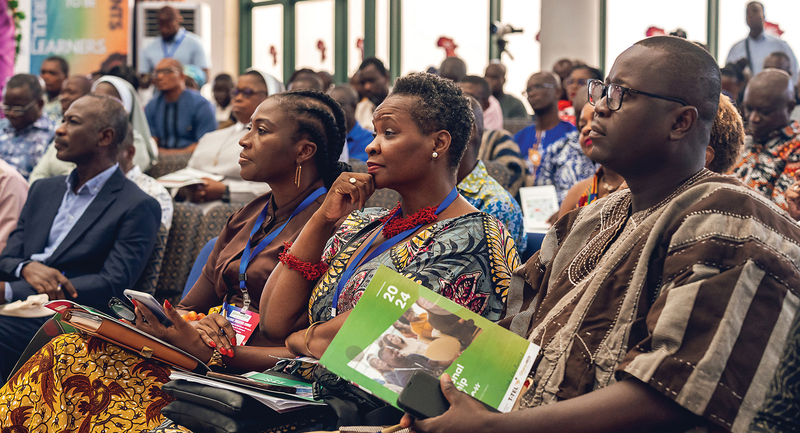Effective instructional leadership teams (ILTs) are powerful levers for making change in schools. These teams typically include the principal, assistant principal, instructional coaches, teacher leaders, and other school leaders and can provide a systematic way for schools to execute their most important priorities. However, their effectiveness is not a given. Over the nearly two decades that I've been supporting ILTs, I've seen that despite educators' best efforts, many initiatives in schools fail due to poor execution. Unfortunately, good intentions are not good enough when it comes to driving and sustaining growth.
Effective ILTs are intentional in many ways, including how and why they are organized, facilitated, and supported. When these components are purposely woven together, the complex fabric of an effective meeting and team is truly present. Let's unpack each of them briefly.
Component 1: Intentionally Organized
Determining who serves on the ILT, when and where they will meet and for how long, and the goals and objectives of the meetings are all part of the intentional organization of an ILT. These actions are just good practice. But that doesn't mean they are easy to implement.
First, it's important to note that the team composition can be dynamic. There's no requirement that says once on the team, always on the team. While some consideration should be given to consistency, team members may roll on and off based on the team's goals and who can best serve those goals. Team size can vary depending on school size, but we typically see between five and ten members on an ILT. Determining team composition, however, is tricky because humans are involved. Consider bringing in a mix of visionaries, those who generally take a long-term view and naturally think about sustainability, and integrators, those who are great at getting things done by tackling issues daily, keeping people disciplined and focused, and translating big ideas into action.
There will inevitably be people in the building who will ask, "Why wasn't I selected to serve on the ILT?" Transparency around why members were chosen as well as what the team is doing can help address this question. Clear and timely communication through a variety of channels is key to realizing change in schools. Besides sharing updates in staff meetings and weekly emails, make connections to your work during hallway conversations and in PLC meetings and coaching sessions.
As for the gatherings, the nature of good meeting agendas and structures can be a bit deceptive. Many ILT meetings become mired in a "rabbit hole" of problems. Without a clear structure to keep the team focused, these meetings can quickly devolve into hour-long "problem-naming" sessions without a clear process for prioritizing the most important problems to discuss. One middle school in Indiana that I had the opportunity to support was struggling with these very issues, and the ILT felt like their meetings were unproductive. After careful consideration, they adopted the 5-Star Meeting protocol, a framework developed by the Insight Education Group, my organization, that emphasizes personal and professional connections, individual contributions, lively team discussions focused on the most important issues, and an honest evaluation at the end of the meeting that allows the team to identify specific ways to improve collaboration from one meeting to the next. The 5-Star Meeting protocol provided decision-making structures that resulted in clear next steps and owners. This ultimately increased productivity and brought a disciplined cadence to the team's meetings.
When the team was first introduced to this intentional meeting structure, they thought it would be relatively easy to use. However, they not only needed to learn the mechanics of the agenda, they also needed to learn how to effectively interact with one another. This is where intentional facilitation is critical.
Component 2: Intentionally Facilitated
Effective ILTs require strong yet agile facilitation. Certainly, a well-organized agenda and meeting protocol can help with strong facilitation, but there has to be room for flexibility. ILTs often deal with complex, adaptive challenges such as how to more effectively support a teacher or group of teachers, how to create a stronger culture of learning in a school, or how to more effectively engage parents as partners in the learning process. These adaptive challenges often require changes in values, beliefs, roles, relationships, and approaches to the work. Solutions to such challenges often require experiments and new discoveries. A skilled facilitator must find ways to keep the team motivated when an attempted solution yields poor results and redirect them to find another possible solution without losing momentum. Therefore, it is critical to create a safe space in which team members feel empowered to learn and grow together by engaging in conversations, innovating in their work, and experimenting with new approaches.
While there is no one "right" way to facilitate an ILT meeting, here are a few common practices that I've used and that I've seen ILT facilitators use to ensure effective meetings.
- Start and end on time. Being disciplined about starting and ending on time not only shows respect to those who always arrive on time, but also contributes to the culture of efficiency that's important for meetings.
- Use personal/professional check-ins. Never skip these! This brief exercise deepens the human connection and enhances the team's ability to trust, support, and collaborate with one another. The check-in is quite simple: The facilitator asks each team member to share a personal or professional "best" from the previous week (or a brief challenge). Every team member participates to set the tone that all voices are important. Good books, new movies, binge-watch worthy shows, proud parenting moments, and coaching breakthroughs are often shared during the check-in.
- Push thinking through questioning. Nobody likes a know-it-all. Use questioning to seek diversity of thought and draw people out. Smart questions are often harder to pose, but more productive, than just telling the team your own thoughts or answers. After all, if you already have the answers, why meet as a team? Some of the best questions are the simplest: What is the potential upside and downside of a proposed solution? What challenges can we anticipate and how can we mitigate these challenges? Questions like these encourage the team to "push on" or pressure-test possible solutions.
- Confront issues and address challenges. Meetings should be about solving problems, which first requires naming a problem. This alone can be unpopular because "problem namers" can sometimes be perceived as negative, thus causing others to disengage in a meeting when negativity is introduced. Creating an ILT culture that views problem naming as essential to its work is critical. When naming a problem, try phrasing it in the form of a question that, if the team answers, will result in positive movement toward solving the problem. For example, rather than just saying, "Our Algebra I scores are terrible," ask, "What can we do to improve Algebra I scores for our cohort of 9th grade students?" Framing the problem as a question inherently makes the issue more positive, solvable, and specific—three key criteria to use when confronting issues and addressing challenges.
- Engage all members. As with pushing thinking through questioning, it is important to engage all members of the ILT to encourage diversity of thought, which will lead to a more robust conversation and ultimately a better solution. Engaging all members doesn't just happen when the ILT meets; it should also happen before the ILT is formed (when thinking about who will provide a diverse, productive perspective) and in between meetings (by being thoughtful about each person's role in next steps and "to do's").
- Give context and examples when offering suggestions or raising an issue. ILT members gain confidence in a possible solution by trying or modeling it in multiple contexts. For example, imagine the ILT is struggling with the utilization of academic vocabulary across multiple content areas and classrooms. Rather than simply identifying a strategy for teaching academic vocabulary and requesting that all teachers use it, the ILT can view the challenge through the lens of multiple contexts. What would the strategy look like if used in multiple grade levels and content areas? By testing a strategy in different settings, possible flaws will be elevated for the team to address. This level of analysis often results in more robust, sustainable solutions.
- Use graciousness, humor, and purpose. These three attitudes speak to the human nature of our work. The field of education requires close attention to the feelings, hopes, struggles, and dreams of individuals. In an ILT setting, we must remember that each educator on the team needs to get something out of the meeting and not just contribute. Whether it be a simple thank you from respected peers on the ILT, a laugh or two with colleagues during the meeting, or having the opportunity to voice their purpose or "why" for being an educator, such actions can contribute to the personal and professional satisfaction of ILT members.
Component 3: Intentionally Supported
School-based ILTs are unlikely to thrive without intentional support at the district level. That support should start with modeling. One of the best ways for district leaders to do this is to replicate the structures and components of effective ILTs in their own meetings. Central office teams that employ the same level of intentionality with the organization and facilitation of their meetings will be much better positioned to support the work of ILTs in the field. Central office teams will not only gain credibility at the site level by "practicing what they preach," but they will also unearth the real challenges associated with leading effective team meetings. As central office teams problem-solve these challenges, they can share lessons learned with the ILTs they support.
A recent experience I had working with a large district in the Southeast taught me the value of such intentional modeling and support. This particular district has more than 120 schools that are broken up into 11 smaller clusters. Each cluster is supervised by an executive director (ED) in the central office. The EDs had identified a common challenge of improving the level of instructional and distributed leadership at their school sites and decided that improving the ILT structure would be a good way to address this challenge. However, it was clear that there were very different opinions about what an effective ILT looked and sounded like. With a bit of discussion, the ED team agreed to use a common meeting structure (the 5-Star Meeting protocol). They then applied the components of intentional organization and facilitation to their ED meetings, and a few key learnings emerged.
First was the importance of alignment. The EDs realized that they needed to be more intentional about aligning their work to the annual goals and metrics of the district's strategic plan. They had been working hard to solve problems that emerged in their schools on a daily basis, but this "firefighting" mentality in many cases distracted them from focusing on the bigger picture.
They also learned that schools or districts must define what good instruction looks like, and ILTs must constantly refer back to this definition as their guidepost. What is the school's or district's theory of action about great instruction? What inputs will produce the types of learning and achievement desired? While such questions may seem basic, ineffective meetings can result from the lack of a clear definition of what great teaching looks like (e.g., instructional frameworks or "look fors") or, if a good definition exists, a lack of focus on it. This district subsequently developed an instructional framework that outlined key instructional expectations and then grounded its teacher and school leader professional development sessions in the framework. This helped create a foundation for ILTs.
Defining good instruction is critical because it serves as the rudder for the school-based ILT. Without this rudder, the team will lack focus and experience meeting fatigue, since there will be no clear goal on which the team can focus. The team may choose to address poor literacy achievement based on the latest benchmark data, but without a clear understanding of how to position that problem in the context of a clear goal, such as 90 percent of students reading on grade level, the team will not be able to effectively set milestones.
Additionally, without a clear understanding of what good reading instruction looks like, the team will struggle to find possible strategies to address the problem. Therefore, it is critical to have clear outcome-based and input-based goals. The outcome-based goal, in this example, would be the level of reading proficiency to be achieved. The input-based goal would focus on a strategy or strategies that could be tested as a possible solution.
Bringing It All Together
It's important not to forget that these three components must be viewed and implemented collectively rather than in isolation. When they are at work simultaneously, several positive things happen. First, meetings become much more focused. With a clear structure for identifying and discussing next steps and for solving issues, ILTs truly become the lever for making change happen. Second, the ILT meeting structure provides discipline to get the work done. There's a set time and place to meet, members know their roles, and there's a clear set of incremental goals to achieve. Third, these three components together provide a framework for accountability. With team members authentically engaged and invested in the process of change, they gain a clearer sense about their individual responsibilities to the work as a whole.
It's been exciting to watch how instructional leadership teams with these components in place can help schools gain incredible traction on their biggest challenges—and experience the wins they've been seeking.









